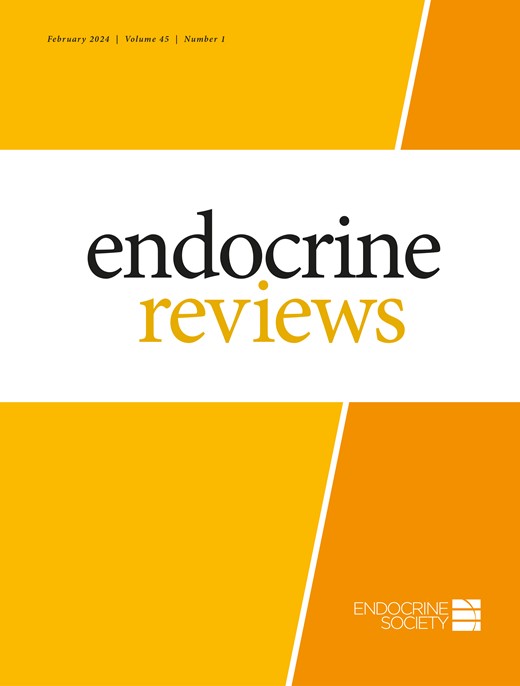基于glp -1的新型2型糖尿病和肥胖症药物。
IF 22
1区 医学
Q1 ENDOCRINOLOGY & METABOLISM
引用次数: 0
摘要
西马鲁肽和替西帕肽的批准为2型糖尿病和肥胖症的治疗树立了新的标杆。基于他们的成功,新的基于glp -1的治疗方法正在迅速发展。这些新一代药物不仅与GLP-1受体结合,还与其他胃-肠-胰腺激素(如葡萄糖依赖性胰岛素性多肽(GIP)、胰高血糖素、胰淀素和YY肽(PYY))受体结合,通过协同机制增强能量摄取、储存和消耗。GIP受体激动作用和拮抗作用,特别是与GLP-1受体激动作用的结合,都显示出了希望。Maridebart cafraglutide结合GLP-1R激动剂和GIPR拮抗剂,体现了这种创新方法。胰高血糖素协同激动剂,如利伏肽和马杜肽,已被证明能显著减轻体重和改善血糖控制。以胰肽为基础的药物,包括CagriSema (cagrilintide + semaglutide)和amycretin,通过互补作用增强饱腹感和血糖结局。进一步的创新见于三重激动剂,如利特鲁肽,其靶向GIP, GLP-1和胰高血糖素受体,以扩大代谢作用。同时,口服小分子GLP-1受体激动剂如danuglipron和orforglipron等抗酶降解药物的出现,标志着患者友好型药物递送的重大进展。这篇综述探讨了这些新型药物的机制、临床发展和治疗潜力,不包括已经批准的药物,如利拉鲁肽、西马鲁肽和替西帕肽。我们强调了多受体激动剂和口服glp -1为基础的疗法如何通过提供更有效和更好耐受的选择来重塑肥胖和2型糖尿病治疗的未来前景。本文章由计算机程序翻译,如有差异,请以英文原文为准。
Novel GLP-1-Based Medications for Type 2 Diabetes and Obesity.
The approvals of semaglutide and tirzepatide have set new benchmarks in the treatment of type 2 diabetes and obesity. Building on their success, novel GLP-1-based therapeutics are rapidly advancing. These next-generation agents engage not only GLP-1 receptors but also those for other gastro-entero-pancreatic hormones such as glucose-dependent insulinotropic polypeptide (GIP), glucagon, amylin, and peptide YY (PYY) to enhance energy uptake, storage, and expenditure through synergistic mechanisms. Both GIP receptor agonism and antagonism, particularly in combination with GLP-1 receptor agonism, have shown promise. Maridebart cafraglutide, combining GLP-1R agonism with GIPR antagonism, exemplifies this innovative approach. Glucagon co-agonists like survodutide and mazdutide have demonstrated significant weight loss and improved glycemic control. Amylin-based agents, including CagriSema (cagrilintide + semaglutide) and amycretin, enhance satiety and glycemic outcomes through complementary actions. Further innovation is seen in triple agonists such as retatrutide, which targets GIP, GLP-1, and glucagon receptors to amplify metabolic effects. Meanwhile, the emergence of orally active small-molecule GLP-1 receptor agonists like danuglipron and orforglipron, which are resistant to enzymatic degradation, marks a major advance in patient-friendly drug delivery. This review explores the mechanisms, clinical development, and therapeutic potential of these novel agents, excluding already approved drugs like liraglutide, semaglutide, and tirzepatide. We highlight how multi-receptor agonists and oral GLP-1-based therapies may reshape the future landscape of obesity and type 2 diabetes treatment by offering more effective and better-tolerated options.
求助全文
通过发布文献求助,成功后即可免费获取论文全文。
去求助
来源期刊

Endocrine reviews
医学-内分泌学与代谢
CiteScore
42.00
自引率
1.00%
发文量
29
期刊介绍:
Endocrine Reviews, published bimonthly, features concise timely reviews updating key mechanistic and clinical concepts, alongside comprehensive, authoritative articles covering both experimental and clinical endocrinology themes. The journal considers topics informing clinical practice based on emerging and established evidence from clinical research. It also reviews advances in endocrine science stemming from studies in cell biology, immunology, pharmacology, genetics, molecular biology, neuroscience, reproductive medicine, and pediatric endocrinology.
 求助内容:
求助内容: 应助结果提醒方式:
应助结果提醒方式:


